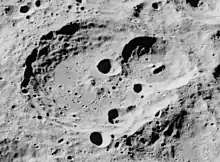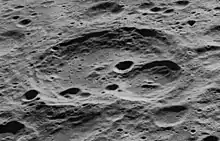Seyfert (crater)
Seyfert is a prominent lunar impact crater that is located on the far side of the Moon. It was named after American astronomer Carl Keenan Seyfert.[1] It lies behind the eastern limb of the Moon, to the east of the crater Espin. Just to the north of Seyfert is the crater Harriot and equally close to the south is Polzunov.
 Oblique Apollo 16 image (facing northwest) | |
| Coordinates | 29.1°N 114.6°E |
|---|---|
| Diameter | 110 km |
| Depth | Unknown |
| Colongitude | 247° at sunrise |
| Eponym | Carl K. Seyfert |


The outer rim of this crater is slightly elongated to the north, and the northeastern rim is overlain by the satellite crater Seyfert A. This overlapping impact crater has a central ridge on its interior floor. There is a low ridge near the midpoint of Seyfert, but it is less prominent. The inner wall of Seyfert is wider along the northern edge, west of Seyfert A.
Several small craters lie along the rim and interior of Seyfert, including a merged group of small craters along the eastern inner wall, a small crater intruding into the southeastern rim, and a pair of small craters along the southern rim of Seyfert A. The interior floor of Seyfert is relatively level, and is marked by a number of tiny craterlets. Traces of the ray system from Giordano Bruno to the northwest lie along the rim and interior floor of Seyfert.
Satellite craters
By convention these features are identified on lunar maps by placing the letter on the side of the crater midpoint that is closest to Seyfert.
| Seyfert | Latitude | Longitude | Diameter |
|---|---|---|---|
| A | 30.5° N | 114.9° E | 53 km |
References
- Citations
- "Seyfert (crater)". Gazetteer of Planetary Nomenclature. USGS Astrogeology Research Program.
- Andersson, L. E.; Whitaker, E. A. (1982). NASA Catalogue of Lunar Nomenclature. NASA RP-1097.CS1 maint: ref=harv (link)
- Bussey, B.; Spudis, P. (2004). The Clementine Atlas of the Moon. New York: Cambridge University Press. ISBN 978-0-521-81528-4.CS1 maint: ref=harv (link)
- Cocks, Elijah E.; Cocks, Josiah C. (1995). Who's Who on the Moon: A Biographical Dictionary of Lunar Nomenclature. Tudor Publishers. ISBN 978-0-936389-27-1.CS1 maint: ref=harv (link)
- McDowell, Jonathan (July 15, 2007). "Lunar Nomenclature". Jonathan's Space Report. Retrieved 2007-10-24.CS1 maint: ref=harv (link)
- Menzel, D. H.; Minnaert, M.; Levin, B.; Dollfus, A.; Bell, B. (1971). "Report on Lunar Nomenclature by the Working Group of Commission 17 of the IAU". Space Science Reviews. 12 (2): 136–186. Bibcode:1971SSRv...12..136M. doi:10.1007/BF00171763.CS1 maint: ref=harv (link)
- Moore, Patrick (2001). On the Moon. Sterling Publishing Co. ISBN 978-0-304-35469-6.CS1 maint: ref=harv (link)
- Price, Fred W. (1988). The Moon Observer's Handbook. Cambridge University Press. ISBN 978-0-521-33500-3.CS1 maint: ref=harv (link)
- Rükl, Antonín (1990). Atlas of the Moon. Kalmbach Books. ISBN 978-0-913135-17-4.CS1 maint: ref=harv (link)
- Webb, Rev. T. W. (1962). Celestial Objects for Common Telescopes (6th revised ed.). Dover. ISBN 978-0-486-20917-3.CS1 maint: ref=harv (link)
- Whitaker, Ewen A. (1999). Mapping and Naming the Moon. Cambridge University Press. ISBN 978-0-521-62248-6.CS1 maint: ref=harv (link)
- Wlasuk, Peter T. (2000). Observing the Moon. Springer. ISBN 978-1-85233-193-1.CS1 maint: ref=harv (link)
External links
| Wikimedia Commons has media related to Seyfert (lunar crater). |